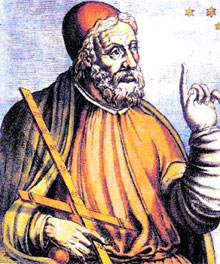
An early Baroque artist's rendition of Claudius Ptolemy
Ptolemy
Claudius Ptolemy (90 – c.168 AD) was the most famous and influential astronomer of antiquity. Ptolemy’s Almagest (or ‘Great Treatise’) is the only comprehensive treatise on astronomy to have survived from the ancient world. It contained star charts and models of celestial motions according to which the Earth was at rest and at the centre of the universe. About it orbited the Sun and the Moon and, in a succession of epicycles, the 5 known planets. Whilst all celestial bodies described circles – considered the most perfect of motions -- Ptolemy found that in order to find agreement with observation their rates of rotation about the centre of their epicycles were not constant. He introduced the equant, a point offset from the centre, about which the rate of change of angle was uniform. The equant was considered an imperfection of his system and was subsequently eliminated by Arab and Persian astronomers like Alhazen. Copernicus considered the elimination of the equant the most important feature of his own heliocentric model.
In his Planetary Hypotheses Ptolemy developed a model of the universe as a whole. Following Aristotle, he conceived it as a set of nested spheres, of which the Sun was set at a radius of 1210 Earth radii and the outermost, the sphere of the fixed stars, was set at 20,000 Earth radii. Although his estimate of the Earth-Sun distance was accurate to about 10%, his geocentric model only specified, for each planet, the ratio of the radius of the epicycle to the radius of the deferent. With an appropriate choice of ratios of deferents, Ptolemy’s systems goes over to that of Copernicus by a simple coordinate transformation.
Ptolemy lived in Alexandria. Whilst he wrote in Greek he is known to have held Roman citizenship, but little else about him is known.
